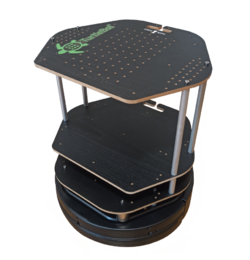Software:TurtleBot
| Developer | Community |
|---|---|
| Written in | Various (Notably C++ and Python) |
| OS family | ROS |
| Working state | Current (TurtleBot 2) |
| Source model | open source, open source hardware |
| Initial release | 2011 |
| Marketing target | Personal robots, mobile robots |
| Default user interface | Many |
| License | BSD, OSHW Statement of Principles and Definition v1.0 |
TurtleBot is a personal robot kit with open source software. It was created at Willow Garage by Melonee Wise and Tully Foote in November 2010.
Versions
TurtleBot 1
TurtleBot 1 consists of an iRobot Create base, a 3000 mAh battery pack, a TurtleBot power board with gyro, a Kinect sensor, a Asus 1215N laptop with a dual core processor, and a hardware mounting kit attaching everything together and adding future sensors.
TurtleBot 2
TurtleBot 2 packs powerful capabilities into one integrated system. At its core sits a YUJIN Kobuki mobile base, outfitted with a robust 2200 mAh battery for extended operation. Sensing comes from a versatile Kinect sensor, while an Asus 1215N laptop provides a dual core processor to handle computation. The included fast charger replenishes the system quickly between deployments.
Bringing everything together, a custom hardware mounting kit attaches the sensors, laptop, and battery securely to the Kobuki base. This unified assembly enables TurtleBot 2 to operate as a flexible mobile robotics research platform, ready to be customized with additional sensors as needed. The all-in-one design makes TurtleBot 2 a versatile starting point for prototyping and exploring cutting-edge robotics applications.
TurtleBot 3
TurtleBot 3 has structural expansion capability due to ROBOTIS’ modular structure with the DYNAMIXEL.
TurtleBot 4
TurtleBot 4 is using a iRobot Create3 robot as a base with a compute and sensor package consisting of a Raspberry PI 4, a Lidar and a RGB-D camera.
Community
TurtleBot has been used in multi-robot research and human robot interaction research.[1] TurtleBot has also been used by universities teaching introductory robotics courses.[2][3][4]
Licensing
TurtleBot is a licensed trademark that is maintained by the Open Source Robotics Foundation. The Open Source Robotics Foundation licenses the use of the TurtleBot trademark for manufacturing and distributing TurtleBot branded products.[5]
References
- ↑ "An exclusive human-robot interaction method on the TurtleBot platform | IEEE Conference Publication | IEEE Xplore". doi:10.1109/robio.2013.6739662. https://ieeexplore.ieee.org/document/6739662/.
- ↑ "University of South Carolina: CSCE574 Robotics". University of South Carolina. http://www.cse.sc.edu/~jokane/teaching/574/.
- ↑ "Johns Hopkins University: ME530707". Johns Hopkins University. http://dscl.lcsr.jhu.edu/ME530707_2014.
- ↑ "School of Engineering Students Leading Robotics Research at St. Thomas". University of St. Thomas. http://www.stthomas.edu/news/school-of-engineering-students-leading-robotics-research-at-st-thomas/.
- ↑ "Become a TurtleBot Manufacturer or Distributor". Open Source Robotics Foundation. http://www.turtlebot.com/become-distributor/.
External links
- TurtleBot Youtube Channel
- TurtleBot GitHub
- Robotis and OSRF Announce TurtleBot 3: Smaller, Cheaper, and Modular
- Hands-on With TurtleBot 3, a Powerful Little Robot for Learning ROS



